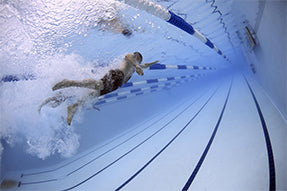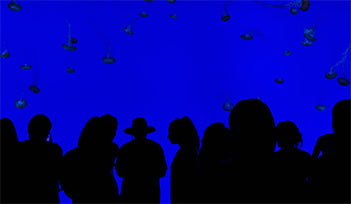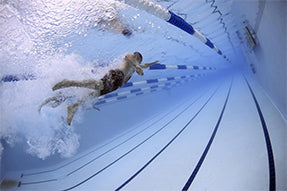Underwater Lighting

Lights can add a lot of ambiance and function to any type of space. When it comes to underwater lighting, there are a few things you need to know. Not all lights can be utilized underwater, so you need to know what to look for when purchasing this type of solution.
There are really only three types of locations where underwater lighting is used. The first is swimming pools whether residential or commercial such as a hotel. The second is when used in landscaping or waterscaping. There is also the matter of aquarium lighting. Each area has different considerations to keep in mind.
Swimming Pools
Lights for swimming pools are typically specified as being swimming pool friendly. For example, the unit will feature elements such as well gasketed edging, submersion proof construction, and low heat emissions. The most important factor with any type of underwater lighting is to check the ratings. For instance, a light solution may be UL listed for damp locations but not wet locations. The other matter to check is the submersion rating. Not all lights that are wet listed can be fully submerged under water. You should also consider the way the chemicals in the pool will interact with the lens of the light since certain metals are more prone to wear and tear caused by chemicals.
Landscaping
For landscaping, adding lights to fountains or ponds is a great way to add gentle ambiance. For this area of lighting, the key is to find solutions with the right lumen output. If you choose a powerful lumen output, you may create a blinding glare when combined with the water. The goal is to find the right lumen output for the movement of the water. For example, if the water is stagnant, opt for a gentler lumen option whereas a waterfall or fountain can have a brighter lumen since you want to draw attention to the moving water. The same considerations of ratings and codes should be used as with swimming pools. If the unit isn’t going to be fully submerged such as when placed behind a waterfall, but it has somewhat constant contact with water, it’s best to opt for submersion rating fixtures anyway. You also want to choose options where the wiring is encased inside the unit or a plug-in solution which allows you to wrap the extra cord around the fixture itself so you won’t have a hard time reaching it when it comes time for maintenance or bulb replacement.
Aquariums
For this area, the biggest consideration is heat. Any location where there are living things, temperature should be taken into consideration. Since lights give off a considerable amount of heat during operation, and certain types of fish and plants can perish with rising temperature, it is crucial to look at this factor when shopping for this area of underwater lighting. The best bet is to opt for LED which emits practically no heat since it is so efficient and doesn’t suffer heat loss during the conversion of energy to illumination.

Aquarium Lighting
If you are an aquarium owner, you understand the importance of lighting for your tank. Lighting plays a few important roles in this type of environment. While you may have become accustomed to usin...
Read Article
Aquatic Center Lighting
The location will always play a role in what types of lighting solutions are ideal. For aquatic center lighting, finding the right lighting can be time-consuming with some trial and error involved....
Read Article High Bay LED Lighting
High Bay LED Lighting
 Industrial Low Bay Lighting
Industrial Low Bay Lighting
 Industrial Strip Lights
Industrial Strip Lights
 Vapor Tight Lighting
Vapor Tight Lighting
 LED Shop Lights
LED Shop Lights
 Hazardous Area / Explosion Proof Lighting
Hazardous Area / Explosion Proof Lighting
 Loading Dock Lights
Loading Dock Lights
 Construction / Portable Lighting
Construction / Portable Lighting
 Industrial Ceiling Fans
Industrial Ceiling Fans
 LED Work Lights
LED Work Lights
 Clearance
Clearance
 Troffer Lights
Troffer Lights
 LED Flat Panel Lights
LED Flat Panel Lights
 Drop Ceiling Lights
Drop Ceiling Lights
 Suspended LED Lights
Suspended LED Lights
 Exit / Emergency
Exit / Emergency
 Wrap Lighting Fixtures
Wrap Lighting Fixtures
 Gooseneck and Barn Lights
Gooseneck and Barn Lights
 Commercial Stairway Lighting
Commercial Stairway Lighting
 Hospital Bed Lights
Hospital Bed Lights
 Commercial Sign Lights
Commercial Sign Lights
 UV Disinfecting Lights & Air Purifier Fixtures
UV Disinfecting Lights & Air Purifier Fixtures
 Recessed Lighting
Recessed Lighting
 Wafer Lighting
Wafer Lighting
 RGB LED Lights
RGB LED Lights
 Grow Lights
Grow Lights
 Refrigeration Lighting
Refrigeration Lighting
 LED Flood Lights
LED Flood Lights
 Outdoor Wall Lights
Outdoor Wall Lights
 LED Area Lights
LED Area Lights
 Parking Lot Lights & Poles
Parking Lot Lights & Poles
 Outdoor Post Top Lights
Outdoor Post Top Lights
 LED Stadium Lighting
LED Stadium Lighting
 Canopy Lights
Canopy Lights
 Security Lights
Security Lights
 LED Bollard Lights
LED Bollard Lights
 Solar Powered LED Lighting
Solar Powered LED Lighting
 Dusk to Dawn Lights
Dusk to Dawn Lights
 Landscape Lighting
Landscape Lighting
 Outdoor String Lights
Outdoor String Lights
 Coastal Wildlife Lighting
Coastal Wildlife Lighting
 Outdoor House Lights
Outdoor House Lights
 Ceiling Fans
Ceiling Fans
 Ceiling Lights
Ceiling Lights
 Chandelier Lights
Chandelier Lights
 Pendant Lighting
Pendant Lighting
 Island Lights
Island Lights
 Track Lighting
Track Lighting
 Under Cabinet Lighting
Under Cabinet Lighting
 Vanity Lights
Vanity Lights
 Wall Sconces
Wall Sconces
 LED Tape Lights
LED Tape Lights
 LED Light Bulbs
LED Light Bulbs
 LED Tube Lights
LED Tube Lights
 LED Corn Lights
LED Corn Lights
 Vintage LED Bulbs
Vintage LED Bulbs
 Decorative LED Bulbs
Decorative LED Bulbs
 Fluorescent Light Bulbs
Fluorescent Light Bulbs
 Metal Halide Lamps
Metal Halide Lamps
 Shatterproof Light Bulbs
Shatterproof Light Bulbs
 LED Magnetic Strip Retrofit Kits
LED Magnetic Strip Retrofit Kits
 LED Strip Light Retrofit Kits
LED Strip Light Retrofit Kits
 High Bay LED Retrofit Kits
High Bay LED Retrofit Kits
 LED Troffer Retrofit Kits
LED Troffer Retrofit Kits
 LED Wall Pack Retrofit
LED Wall Pack Retrofit
 LED Street Light Retrofit Kits
LED Street Light Retrofit Kits
 Recessed Lighting LED Retrofit Kits
Recessed Lighting LED Retrofit Kits
 CFL Ballasts
CFL Ballasts
 Electronic Halide Ballast
Electronic Halide Ballast
 Emergency Ballasts & Inverters
Emergency Ballasts & Inverters
 Fluorescent Ballasts
Fluorescent Ballasts
 LED Drivers
LED Drivers
 High Pressure Sodium Ballasts
High Pressure Sodium Ballasts
 Metal Halide (HID) Ballasts
Metal Halide (HID) Ballasts
 Pulse Start Metal Halide Ballasts
Pulse Start Metal Halide Ballasts
 Electric Vehicle Chargers
Electric Vehicle Chargers
 Ballasts & Drivers
Ballasts & Drivers
 Electrical Supplies
Electrical Supplies
 Electrical Tools
Electrical Tools
 Switches & Receptacles
Switches & Receptacles
 Hand Dryers
Hand Dryers
 Electrical Power Cords
Electrical Power Cords
 Sensors and Timers
Sensors and Timers
 Smart Home Automation
Smart Home Automation
 High Bay Occupancy Sensors
High Bay Occupancy Sensors
 Outdoor Motion Sensor Lights
Outdoor Motion Sensor Lights
 Walkway Lights
Walkway Lights
 Office Lights
Office Lights
 Gym Lighting
Gym Lighting
 Exterior Building Lights
Exterior Building Lights
 Sports Lighting
Sports Lighting
 Hospital Lights
Hospital Lights
 Airport Lights
Airport Lights
 Classroom Lights
Classroom Lights
 Factory Lights
Factory Lights
 Restaurant Lights
Restaurant Lights
 Corridor Lights
Corridor Lights
 Church Lights
Church Lights




